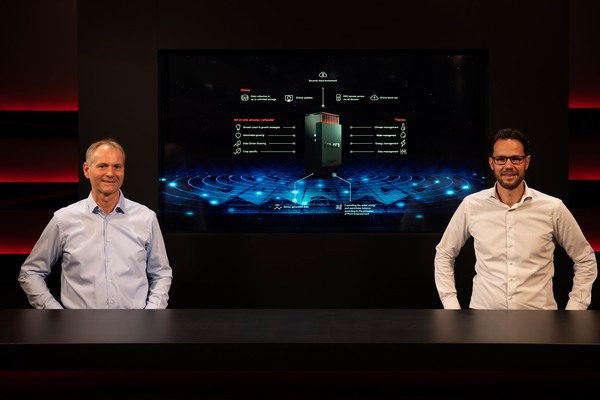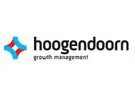Late last year, Hoogendoorn Growth Management had big news. This Dutch company proudly presented 'its biggest innovation to date' - IIVO. This is a next-level processing computer. And it's the horticultural automation company's new flagship project. But, at the same time, Hoogendoorn had another announcement. Peter Hendriks was to become a CEO.
That appointment became official on 1 Janaury 2021. So, there was no better time to interview Peter (39). We spoke to this new Hoogendoorn director about innovation, algorithms, and partnerships to help the company to keep moving forward. "With IIVO, we've created all the conditions to go full steam ahead," begins Peter.
 Peter (r) forms part of the company's management team alongside familiar faces - Martin Helmich (l) and Freerk Visser (not pictured). Martin remains responsible for commercial client and partner relations. Freek will see to the operational side of things. Peter is focusing on innovation and strategy.
Peter (r) forms part of the company's management team alongside familiar faces - Martin Helmich (l) and Freerk Visser (not pictured). Martin remains responsible for commercial client and partner relations. Freek will see to the operational side of things. Peter is focusing on innovation and strategy.
Expertise
The company has spent the last few years quietly working toward this goal. "We put 50 years of code aside to build something truly new. For us, IIVO is the first huge step towards automated cultivation."
For IIVO, 'all past developments and regulations were held up to the light again'. What's good, and what could be improved? Above all, what will be required in the future in this rapidly changing international world? This resulted in a robust, intelligent system. Compared to its predecessor, iSii, it's 'even more user-friendly and versatile'. It's also straightforward to expand.
“Growers and crop consultants can set up the system to exactly suit their needs. That's where IIVO is no different from the iSii. However, we've greatly improved the user experience. That's when it comes to dashboards and data provision. It's much easier to operate remotely. Operating multiple locations is super simple, and back-ups and updates are set automatically," says Peter.
But Hoogendoorn has also made great strides regarding schemes and their use. "We've put great effort into adding algorithms and making the schemes smarter. We followed the Plant Empowerment principles for this. We've already demonstrated this to the general public too. That was, as part of the winning team, in the last Autonomous Greenhouse Challenge."
Clients can choose if they'd like to apply these principles in the future too. "Our focus was and is on innovation, but it's entirely client-orientated. That's why we're in constant dialogue with them. What should we be developing or not? Is our strategy correct? Our clients are, after all, the ones using the system in their greenhouses. They're, therefore, busy with autonomous cultivation. The challenge was to prove that the algorithms work, which we did. Now the question is, are people eagerly awaiting this new idea?" Hendriks wonders.
Rather EI than AI
Still, many people don't embrace the idea of 'autonomous cultivation'. Peter's aware of that. He doesn't like using that umbrella term. People often mention this in the same breath as Artificial Intelligence. "We prefer to use the term 'data-driven cultivation'. That's what IIVO allows growers to do. More data is becoming available. That enables us to write better and better algorithms. That's our expertise - Expert Intelligence. Computers can use this, along with the cultivation data collected in practice, to make decisions."
What's vital here is that growers can always understand and explain 'the system's' decisions. "That's why, in data-driven cultivation, we work according to the Plant Empowerment principles. That theoretical framework contains all the basic rules on which we base our automatic cultivation control. Say the screens, temperature, or humidity are controlled slightly differently to what the grower's accustomed. These rules must be able to explain why."
"Ideally, growers should first learn about these principles. They should then put it into practice. Only in step three do we let the climate computer do its work automatically. This prevents growers from immediately turning off the algorithm button if the greenhouse climate is 'different' from what they're used to," Peter explains.
"Of course, growers can always determine their own strategy, together with their consultant. They can adjust it accordingly. In this way, you let the algorithms do the work for you. Experience shows that IIVO, with its millions of lines of code, allows growers to cultivate their products very smartly and at a high level."
In the coming years, 'rule-driven' greenhouse management will increasingly become 'algorithm-driven'.That still differs from fully 'autonomous cultivation'. "You still need people on the ground keeping an eye on things," Peter says.
The idea that Artificial Intelligence can solve everything sounds great. But Peter doesn't see this happening. Nor does he see the value of deep learning here. That could include self-learning algorithms based on past data. "When it comes to climate control, we very deliberately didn't opt for this at present. It's great to use for harvest forecasting, for example. It can predict the harvest ever better."
"But there's a danger when it comes to greenhouse climates. The system might read in incorrect past information. For instance, from a time when the climate wasn't yet optimal. Or it could include mistakes made when reading the system's behavior. We believe you should use Artificial Intelligence to predict what will happen. You should, however, use Expert Intelligence to determine whether what the best thing is to do. We, therefore, combine the two in IIVO," the new CEO continues.
Flexible foundation
Soon, more growers will be introduced to IIVO and its Expert Intelligence. "While developing IIVO, internationalization was considered far more than when we were developing its predecessor, iSii. In the coming years, horticulture acreage will continue to grow very rapidly. That's needed to properly feed the world's population. It will expand much faster than growers can be trained."
"That increase demands innovative, improved techniques. Now, IIVO offers a flexible foundation for continued development, without running the risk of it becoming obsolete," Peter says. "That's why we've put so much energy into making it possible to update the system remotely. We no longer have to physically insert a CD, as we used to call it. Now, we can distribute new updates remotely, online. After extensive testing, of course."
They may have introduced this innovative system, but the people at this Dutch company aren't sitting back. They can really get going with IIVO. At the same time, they're keeping their ears and eyes open. What do clients and growers want? They also want to see what potentially interesting innovations from inside and outside horticulture are on offer.
"I certainly consider things like new robotics and sensors from an innovation perspective. These are making more and more previously 'unmeasurable' things measurable. The principles of Plant Empowerment, in which the plant is central, are invaluable. So, with the help of IIVO, growers will farm even smarter," Peter concludes.
For more information:
Hoogendoorn Growth Management
Website: www.hoogendoorn.nl
Email: info@hoogendoorn.nl
Peter Hendriks
Email: phe@hoogendoorn.nl
